BibTeX | RIS | EndNote | Medlars | ProCite | Reference Manager | RefWorks
Send citation to:
URL: http://jhsw.tums.ac.ir/article-1-27-en.html
Introduction: Work-related musculoskeleta ldisorders (WMSDs) of upperlimbs (UL)in the last 35 years have become extremely widespread, reaching epidemiclevels, inalladv ancedindustrializedcountries. They are considered the main cause of disability, time off work, and requests for healthcare
.
Method and Materials: For detailed risk assessment, ISO -11228-3 is the preferred method. It is recommended for the specific purposes of ISO -11228-3(2007) because, given the knowledge at the time of publication, it considers all the relevant risk factors, is also applicable to “multitask jobs”, and provides criteria - based on extensive epidemiological data - for forecasting the occurrence of UL-WMSD (upper limb work-related musculoskeletal disorders) in exposed working populations. In this method is the ratio between the number of actual technical actions, ATA, carried out during a work shift and the number of reference technical actions, RTA, for each upper limb, specifically determined in the scenario under examination.
.
Results: Results shown in 4 workstations include 35 task in an automotive industry. One of them is red and another’s are green.
.
Conclusion: This method is suitable, quickly and very easy to use for assessment of ergonomics situation in work.
| Rights and permissions | |
 |
This work is licensed under a Creative Commons Attribution-NonCommercial 4.0 International License. |



